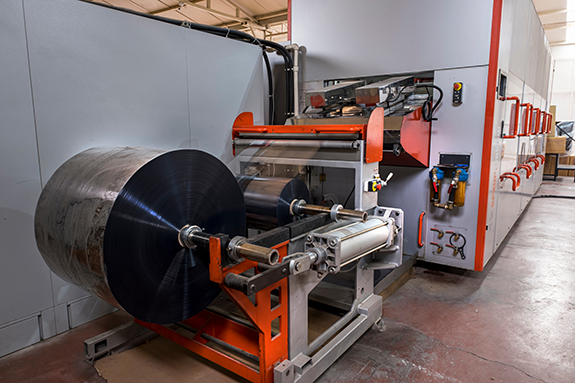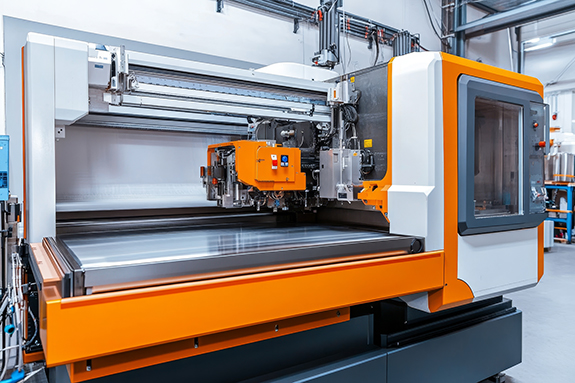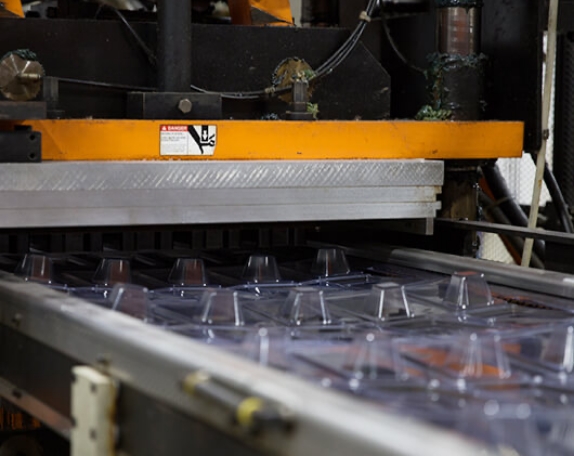Heavy Gauge Thermoforming
Rounding out the capabilities of VisiPak is heavy gauge thermforming, also known as large gauge thermoforming or thick gauge thermoforming.
It is these latter two names that helps understand what products and industries are best served by heavy gauge thermoforming.
What is Heavy Gauge Thermoforming?
First, let’s review the opposite to help explain differences between thin and heavy gauge thermoforming.

Thin Gauge Thermoforming
To contrast, let’s recall that thin gauge thermoforming uses rolled sheets that are placed over a mold until cooled. Thin gauge material is dominant in the disposable packaging sector, especially in the retail markets, particularly because of the light-weight aspect. Another primary reason for its popularity is the recyclability of the end product. Also, less material is often considered of value with thin gauge products.
Thick or Heavy Gauge Thermoforming
Heavy gauge thermoforming, on the other hand, uses pre-cut stacked sheets. Heavy or thick gauge material is often needed for very large and sturdy items with much lower volume requirements than thin gauge thermoforming. These large gauge thermoformed parts are designed to exist for very long periods of time, not as disposable items.
VisiPak is capable of manufacturing with the maximum sheet size of 36″ x 60″ and a 10″ – 12″ draw is possible. The draw is important because it guides material selection. The minimum gauge of the plastic sheet is estimated for each project, and this in turn affects material cost estimates. The thickest material we run is 0.3125″.


Heavy Gauge Thermoforming Applications
Heavy or thick gauge thermoforming is commonly used to produce permanent components in such things as refrigerators, automobiles, spas, car bumpers, heavy duty medical equipment, fitness equipment, construction equipment, and even plastic lawn chairs. Each of these assume a similar characteristic – they are larger items. Heavy gauge thermoformed products tend to be more sturdy. Large objects require large sheets and are often produced at a slower rate because it takes longer to heat and cool the thicker plastic. These traits make large or thick guage thermoforming best suited for items requiring durability and lower volumes.
VisiPak has designed large gauge thermoformed trays in simple flat surfaces at varying depths or trays. VisiPak has also designed heavy gauge trays with sections and/or ribbed interior walls.Typical of this kind of parts handling trays are stackable and reuseable features.This reduces shipping and storage costs.
VisiPak has the expertise to design any thick gauge thermoforming project within the above stated sizes.
Manufacturing Differences
A key difference between thick and thin gauge thermoforming is that in thin gauge thermoforming, a production run can create multiple pieces simultaneously, as seen with the clamshells shown here. In this example, the mold was designed to produce five pieces across and possibly four rows, allowing for 20 clamshells to be formed in a single pass. Thick gauge thermoforming parts are produced one at a time.
The creation of a heavy gauge thermoformed product involves specific machinery, processes and control systems. Each has its own uniqueness, but collectively the systems enables operators to develop their expertise not only in operating the machines, but in identifying advantages for efficiencies. Specifics about materials, timing, and heat exposures can prove to be critical.

Heavy Gauge Thermoforming Services
All heavy gauge thermoforming is custom designed, which is an expertise of VisiPak. From conception to final assembly, VisiPak engineering expertise will contribute to your bottom line by giving full consideration to design from start to finish. VisiPak Engineers assist in the entire product development cycle, applying your shared knowledge and requirements to create a design that meets with your approval, create prototypes for testing, oversee tooling production and review production outcome. VisiPak provides heavy gauge thermoforming in our Arnold, MO facility, Building 1, and we are one of the few manufacturers who can provide both thin and heavy gauge thermoforming services.
Heavy Gauge Thermoformed Materials
Thick or heavy gauge thermoformed products are produced from thermoformed plastics, or thermoplastics, which makes them ideal for recyclability. They do not form chemical bonds during the curing process so at high melting points they can be reheated and reshaped. Smooth or textured finishes can be achieved at the sheet extrusion phase or within the final molding phase. PVC is the most commonly used material.
Material Properties
Thermoform plastic sheet properties include:
- Flexible product design
- Color options
- Impact resistance due to structural wall integrity
- Electrical insulation properties (anti-static)
- Distortion
- Heat resistance
- UV resistance
- Water resistant
- Corrosion resistant
- Typically cheaper than fabricated metals
Materials
Here is a list of materials we use.
- PVC (Polyvinyl Chloride)
- PP (Polypropylene)
- PET (Polyethylene terephthalate)
- HDPE (High-Density Polyethylene)
- HIPS (High-Impact Polystyrene)
- PETG (Polyethylene terephthalate glycol)
- ABS (Acrylonitrile Butadiene Styrene)
- OPS (Oriented Polystyrene)
Ready to Get Started?
Request Quote
and/or Samples
Contact sales for volume pricing and
access to free samples for testing and
prototyping.
Contact a
Packaging Specialist
For help finding the best package for
your application or creating one that
is customized to your specific needs.
Shop Our
Online Store
For immediate access to our stock
packaging tubes, clamshells,
containers, caps and more.
